


Working together with the
KENNEL CLUB
for a better future
KENNEL CLUB
for a better future
Malassezia Pachydermatitis
What is it?
Malassezia pachydermatitis is a common, vigorous yeast organism that is found on healthy, normal and abnormal canine skin and in ears. All dogs have this.
It is a yeast which is a commensal, that is an organism which lives with an organism of a different species. On normal healthy skin it causes no problems. However, when changes in the skin allow it, the organism can multiply and cause inflammation of the skin. As the yeast is a “normal flora” it cannot be eliminated - it will always be present. The challenge is to provide treatment to control it.
Dermatitis caused by Malassezia Pachydermatis is not really a “primary” condition or infection, that is, an illness on its own. It is really an overgrowth of normal flora which has arisen because “something” in the environment of the skin or ear canal has changed. It is what causes this change which is the primary condition. As a result the yeast multiplies and the objective is 1) to inhibit this overgrowth or multiplication and 2) identify and correct, where possible, the underlying diseases that allowed the yeasts to overgrow in the first place. This is where it gets complicated and there are various views on suitable treatment. One is that the initial treatment is to reduce the inflammation, others consider that the preliminary treatment is to stop the multiplication of yeast. Most specialists adopt the approach of removing the yeast as a first step, then re-evaluating the nature of any residual clinical signs so that underlying diseases can be diagnosed and hopefully managed.
The Basset Hound is not the only Breed to suffer from this condition. It is common in the West Highland White Terrier and the German Shepherd Dog to name but two.
Clinical signs
The Skin
Malassezia pachydermatis can be a complicating factor in a dog of any breed with a skin condition. Some of the factors that can lead to this condition include moisture, as in dogs with skin folds or with pendant ears and/or with narrow ear canals, excessive waxy or scaly build-up, or allergic/bacterial skin disease. Malassezia Pachydermatis may be the primary or initiating cause of skin problems or a secondary cause of dermatitis in any dog with one of these predisposing conditions. This may be related to an alteration in the immune response to the yeast. Dogs with more generalized Malassezia Pachydermatis infection may have typical clinical signs such as Hair Loss, Redness of the Skin, Greasy Coat, Darkening of the Skin, Increased Scale Production, Leathery Skin, Itchiness, Seborrhoeic Smell. The smell is very distinctive and some call it “mousy” or like mushrooms and any or all of these signs may, or may not, be an indicator of Malassezia Pachydermatis.
Distribution of the lesions may be: In One Isolated Area, In a Number of Areas or All Over.
The areas most often affected are:The Abdomen, Under the Front Legs (Armpits), the Visible parts of the Ear, the Face, Feet, Front Legs, Skin Folds.
The Ears
Narrow ear canals and/or pendulous ears retain moisture and wax and inhibit the circulation of air. This can encourage the overgrowth of yeast. Sebum, an oily, waxy substance, is a common cause, especially in pendulous ears, as in the Basset Hound. There is often a distinctive smell from the discharge from the ears and the dog may or may not be in pain and shake his head. It is important that the underlying condition is established.
Diagnosis
First and foremost any underlying disease/condition must be properly diagnosed and treated; whether it is a bacterial infection, an allergy, seborrhea or any condition that suppresses the animal's immune system. Correct diagnosis will essentially determine which treatment is appropriate. In any case, the yeast infection must be cleared up, and then your Vet will look for an underlying cause. If none can be found, and the yeast infection quickly recurs, this might suggest that Malassezia Pachydermatis is the primary problem.
Treatment
This condition is treated with anti-fungal drugs and/or medicated shampoos. The itchiness usually subsides quite quickly, and the skin lesions within a few weeks. Your dog must continue taking the drug or being bathed for another week or so beyond the symptoms disappearing. Often there is recurrence of the yeast infection, although the frequency may be reduced if an underlying cause can be identified and either treated or managed. Sometimes an ongoing, maintenance regime is required to prevent recurring yeast infections. This may involve weekly medicated baths and your dog taking antifungal drugs once or twice a week. However, your Vet will work with you to determine how your dog's skin condition can best be kept under control. Fundamentally, treatment involves creating an environment that is hostile to Malassezia Pachydermatis. To provide an inhospitable environment for this yeast, lipids (or fats) on the skin need to be removed. We do not provide specific product names here but your own Vet will be well aware of what is currently available to suitably treat the condition.
Is it Inherited?
Studies to determine the mode of inheritance or the frequency in the breed have not yet been carried out, but if you look at the end of this article, you will see that research is ongoing. Although little is known about the inheritance of this condition, it is preferable not to use dogs with severe or recurring yeast infections for breeding.
Research
Malassezia Pachydermatis (MP) is currently being researched at the Royal Veterinary College in the UK by Dr Ross Bond, BVMS. PhD. DVD. MRCVS DipECVD. Many studies have been carried out by Dr Bond over the past 17 years, helped out by many Basset owners. During this time hounds have been patch tested to find out how much MP was carried by Bassets and a double blind placebo controlled shampoo study from which came the useful miconazole/chlorhexidine shampoo, Malaseb. There was a study to see if healthy Bassets carried more yeast than other breeds, a study to assess cell-mediated immunity to MP in both healthy and affected hounds, a study to see if Bassets mounted an adequate/inadequate immune response against MP and interdermal testing to test resistance to MP. There were also skin biopsies examined by a pathologist and microscopical techniques and investigation into the control of microbial overgrowth in the ear canal.
A definitive answer to either the causes and/or treatment would be a very welcome and long-awaited result.
We thank Ross Bond for his assistance in compiling this item, for all of the valuable time, help given and his ongoing research.
© Copyright 2011 - Dr Ross Bond, BVMS. PhD. DVD. MRCVS DipECVD.
Malassezia pachydermatitis is a common, vigorous yeast organism that is found on healthy, normal and abnormal canine skin and in ears. All dogs have this.
It is a yeast which is a commensal, that is an organism which lives with an organism of a different species. On normal healthy skin it causes no problems. However, when changes in the skin allow it, the organism can multiply and cause inflammation of the skin. As the yeast is a “normal flora” it cannot be eliminated - it will always be present. The challenge is to provide treatment to control it.
Dermatitis caused by Malassezia Pachydermatis is not really a “primary” condition or infection, that is, an illness on its own. It is really an overgrowth of normal flora which has arisen because “something” in the environment of the skin or ear canal has changed. It is what causes this change which is the primary condition. As a result the yeast multiplies and the objective is 1) to inhibit this overgrowth or multiplication and 2) identify and correct, where possible, the underlying diseases that allowed the yeasts to overgrow in the first place. This is where it gets complicated and there are various views on suitable treatment. One is that the initial treatment is to reduce the inflammation, others consider that the preliminary treatment is to stop the multiplication of yeast. Most specialists adopt the approach of removing the yeast as a first step, then re-evaluating the nature of any residual clinical signs so that underlying diseases can be diagnosed and hopefully managed.
The Basset Hound is not the only Breed to suffer from this condition. It is common in the West Highland White Terrier and the German Shepherd Dog to name but two.
Clinical signs
The Skin
Malassezia pachydermatis can be a complicating factor in a dog of any breed with a skin condition. Some of the factors that can lead to this condition include moisture, as in dogs with skin folds or with pendant ears and/or with narrow ear canals, excessive waxy or scaly build-up, or allergic/bacterial skin disease. Malassezia Pachydermatis may be the primary or initiating cause of skin problems or a secondary cause of dermatitis in any dog with one of these predisposing conditions. This may be related to an alteration in the immune response to the yeast. Dogs with more generalized Malassezia Pachydermatis infection may have typical clinical signs such as Hair Loss, Redness of the Skin, Greasy Coat, Darkening of the Skin, Increased Scale Production, Leathery Skin, Itchiness, Seborrhoeic Smell. The smell is very distinctive and some call it “mousy” or like mushrooms and any or all of these signs may, or may not, be an indicator of Malassezia Pachydermatis.
Distribution of the lesions may be: In One Isolated Area, In a Number of Areas or All Over.
The areas most often affected are:The Abdomen, Under the Front Legs (Armpits), the Visible parts of the Ear, the Face, Feet, Front Legs, Skin Folds.
The Ears
Narrow ear canals and/or pendulous ears retain moisture and wax and inhibit the circulation of air. This can encourage the overgrowth of yeast. Sebum, an oily, waxy substance, is a common cause, especially in pendulous ears, as in the Basset Hound. There is often a distinctive smell from the discharge from the ears and the dog may or may not be in pain and shake his head. It is important that the underlying condition is established.
Diagnosis
First and foremost any underlying disease/condition must be properly diagnosed and treated; whether it is a bacterial infection, an allergy, seborrhea or any condition that suppresses the animal's immune system. Correct diagnosis will essentially determine which treatment is appropriate. In any case, the yeast infection must be cleared up, and then your Vet will look for an underlying cause. If none can be found, and the yeast infection quickly recurs, this might suggest that Malassezia Pachydermatis is the primary problem.
Treatment
This condition is treated with anti-fungal drugs and/or medicated shampoos. The itchiness usually subsides quite quickly, and the skin lesions within a few weeks. Your dog must continue taking the drug or being bathed for another week or so beyond the symptoms disappearing. Often there is recurrence of the yeast infection, although the frequency may be reduced if an underlying cause can be identified and either treated or managed. Sometimes an ongoing, maintenance regime is required to prevent recurring yeast infections. This may involve weekly medicated baths and your dog taking antifungal drugs once or twice a week. However, your Vet will work with you to determine how your dog's skin condition can best be kept under control. Fundamentally, treatment involves creating an environment that is hostile to Malassezia Pachydermatis. To provide an inhospitable environment for this yeast, lipids (or fats) on the skin need to be removed. We do not provide specific product names here but your own Vet will be well aware of what is currently available to suitably treat the condition.
Is it Inherited?
Studies to determine the mode of inheritance or the frequency in the breed have not yet been carried out, but if you look at the end of this article, you will see that research is ongoing. Although little is known about the inheritance of this condition, it is preferable not to use dogs with severe or recurring yeast infections for breeding.
Research
Malassezia Pachydermatis (MP) is currently being researched at the Royal Veterinary College in the UK by Dr Ross Bond, BVMS. PhD. DVD. MRCVS DipECVD. Many studies have been carried out by Dr Bond over the past 17 years, helped out by many Basset owners. During this time hounds have been patch tested to find out how much MP was carried by Bassets and a double blind placebo controlled shampoo study from which came the useful miconazole/chlorhexidine shampoo, Malaseb. There was a study to see if healthy Bassets carried more yeast than other breeds, a study to assess cell-mediated immunity to MP in both healthy and affected hounds, a study to see if Bassets mounted an adequate/inadequate immune response against MP and interdermal testing to test resistance to MP. There were also skin biopsies examined by a pathologist and microscopical techniques and investigation into the control of microbial overgrowth in the ear canal.
A definitive answer to either the causes and/or treatment would be a very welcome and long-awaited result.
We thank Ross Bond for his assistance in compiling this item, for all of the valuable time, help given and his ongoing research.
© Copyright 2011 - Dr Ross Bond, BVMS. PhD. DVD. MRCVS DipECVD.
This ear is showing obvious signs of Malassezia Pachydermtitis, the ear is clearly inflammed and showing a crusty covering
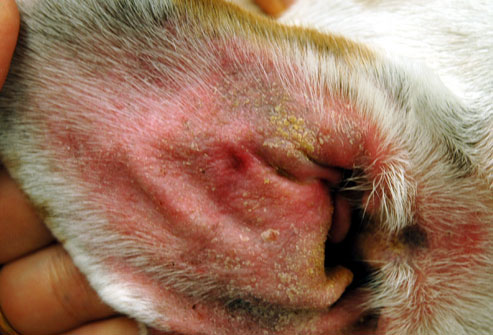
Totally free of any signs of malassezia showing healthy pink clean skin
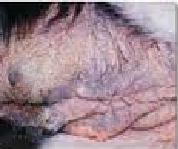
This photo shows how the skin on the stomach of this basset has thickened due to Malassezia
What does Malassezia look like?
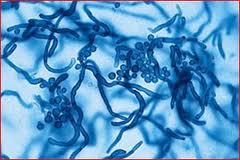
This shows Malassezia (roundish organisms) under the microscope
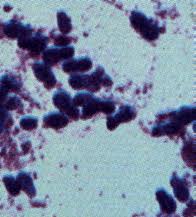
This shows Malassezia taken from a skin scrapping
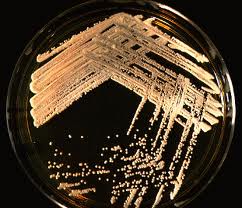
This shows Malassezia growing in a culture under laboritory conditions.

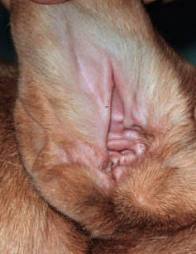



Official site of the Basset Hound Health Group
The Basset Hound Health Group - is run under the auspices of all 8 UK based Basset Hound Breed Clubs
The Basset Hound Health Group - is run under the auspices of all 8 UK based Basset Hound Breed Clubs